Dock landing ship: Difference between revisions
| (33 intermediate revisions by 24 users not shown) | |||
| Line 1: | Line 1: | ||
{{Short description|Type of amphibious warfare ship}} |
|||
{{linkrot|date=October 2018}} |
|||
[[File:USS Harpers Ferry (LSD 49).jpg|thumb|right|{{USS|Harpers Ferry|LSD-49|6}}, a [[United States Navy]] dock landing ship]] |
[[File:USS Harpers Ferry (LSD 49).jpg|thumb|right|{{USS|Harpers Ferry|LSD-49|6}}, a [[United States Navy]] dock landing ship]] |
||
[[File:Quarter view of a Soviet Ivan Rogov class ship.JPEG|thumb|Soviet [[Ivan Rogov class landing ship|''Ivan Rogov''-class landing ship]]]] |
[[File:Quarter view of a Soviet Ivan Rogov class ship.JPEG|thumb|Soviet [[Ivan Rogov class landing ship|''Ivan Rogov''-class landing ship]]]] |
||
A '''dock landing ship''' (also called '''landing ship, dock''' or '''LSD''') is an [[amphibious warfare ship]] with a [[well dock]] to transport and launch [[landing craft]] and [[amphibious vehicle]]s.<ref>{{cite journal |url=https://books.google.com/books?id=8dwDAAAAMBAJ& |
A '''dock landing ship''' (also called '''landing ship, dock''' or '''LSD''') is an [[amphibious warfare ship]] with a [[well dock]] to transport and launch [[landing craft]] and [[amphibious vehicle]]s.<ref>{{cite journal |url=https://books.google.com/books?id=8dwDAAAAMBAJ&q=1954+Popular+Mechanics+January&pg=PA97 |title=Mother of Minesweepers|journal=Popular Mechanics|date=February 1952|pages=97–104, see drawings pp. 98–99}}</ref> Some ships with well decks, such as the Soviet [[Ivan Rogov class landing ship|Ivan Rogov class]], also have bow doors to enable them to deliver vehicles directly onto a beach (like a [[Landing Ship, Tank|tank landing ship]]). Modern dock landing ships also operate helicopters. |
||
A ship with a well deck (docking well) can transfer cargo to landing craft in rougher seas than a ship |
A ship with a well deck (docking well) can transfer cargo to landing craft in rougher seas far more easily than a ship which has to use cranes or a stern ramp.<ref name="gs"> |
||
{{cite web |url=http://www.globalsecurity.org/military/world/amphibious-dock.htm|title=World Wide Landing Ship Dock/Landing Platform Dock| |
{{cite web |url=http://www.globalsecurity.org/military/world/amphibious-dock.htm|title=World Wide Landing Ship Dock/Landing Platform Dock|access-date=2012-05-17}}</ref> The U.S. Navy [[hull classification symbol]] for a ship with a well deck depends on its [[naval aviation|facilities for aircraft]]—a (modern) LSD has a [[helicopter deck]], a [[Amphibious transport dock|landing platform dock]] also has a hangar, and a [[landing helicopter dock]] or [[landing helicopter assault]] has a full-length [[flight deck]].<ref name="gs"/> |
||
==History== |
==History== |
||
The LSD ([[ |
The LSD ([[United States Navy|U.S. Navy]] [[Hull classification symbol|hull classification]] for landing ship, dock) came as a result of a British requirement during the [[World War II|Second World War]] for a vessel that could carry large landing craft across the seas at speed. The predecessor of all modern LSDs is {{ship|Japanese amphibious assault ship|Shinshū Maru||2}} of the [[Imperial Japanese Army]], which could launch her infantry landing craft using an internal rail system and a stern ramp. She entered service in 1935 and saw combat in China and during the initial phase of Japanese offenses during 1942. |
||
| ⚫ | The first LSD of the [[Royal Navy]] came from a design by [[Roland Baker|Sir Roland Baker]] who had designed the British [[landing craft tank]]. It was an answer to the problem of launching small craft rapidly. The landing ship stern chute, which was a converted train ferry ([[SS Train Ferry No. 1|Train Ferry No. 1]] which had been built for British Army use in the [[World War I|First World War]]), was an early attempt. Thirteen [[Landing Craft Mechanized|landing craft mechanized]] (LCM) could be launched from these ships down the chute. The landing ship gantry was a converted [[Tanker (ship)|tanker]] with a crane to transfer its cargo of landing craft from deck to sea—15 LCM in a little over half an hour.<ref>{{Harvard citation no brackets|Brown|2006|p=145}}</ref> |
||
The predecessor of all modern LSDs is {{ship|Japanese amphibious assault ship|Shinshū Maru||2}} of the [[Imperial Japanese Army]], which could launch her infantry landing craft using an internal rail system and a stern ramp. She entered service in 1935 and saw combat in [[China]] and during the initial phase of Japanese offenses during 1942. |
|||
| ⚫ | The design was developed and built in the U.S. for the U.S. Navy and the Royal Navy. The LSD could carry 36 LCM at {{convert|16|kn|kph|lk=in}}. It took one and a half hours for the dock to be flooded down and two and half to pump it out. When flooded they could also be used as docks for repairs to small craft. Smaller landing craft could be carried in the hold as could full-tracked and wheeled amphibious assault or support vehicles. |
||
| ⚫ | The first LSD of the [[Royal Navy]] came from a design by [[Roland Baker|Sir Roland Baker]] who had designed the British [[ |
||
| ⚫ | The design was developed and built in the |
||
[[File:AAVs preparing to debark USS Gunston Hall (LSD 44).jpg|thumb|right|[[Amphibious vehicle]]s inside a US LSD]] |
[[File:AAVs preparing to debark USS Gunston Hall (LSD 44).jpg|thumb|right|[[Amphibious vehicle]]s inside a US LSD]] |
||
[[File:Mounts Bay (L3008).jpg|thumb|right|A British {{sclass2 |
[[File:Mounts Bay (L3008).jpg|thumb|right|A British {{sclass2|Bay|landing ship|1}}]] |
||
==Vessels |
==Vessels== |
||
In the |
In the U.S. Navy, two related groups of vessels classified as LSDs are in service as of 2023, the {{sclass|Whidbey Island|dock landing ship|5}} and {{sclass|Harpers Ferry|dock landing ship|4}}es, mainly used to carry hovercraft ([[Landing Craft Air Cushion|LCAC]]s), operate helicopters, and carry [[United States Marine Corps|Marine]]s.<ref>{{cite web|url=http://www.navy.mil/navydata/fact_display.asp?cid=4200&tid=1000&ct=4|title=The US Navy -- Fact File: Dock Landing Ship - LSD|first=Dan|last=Petty|website=Navy.mil|access-date=27 October 2018}}</ref> |
||
The British [[Royal Fleet Auxiliary]] (RFA) operates three {{sclass2 |
The British [[Royal Fleet Auxiliary]] (RFA) operates three {{sclass2|Bay|landing ship|1}}s based on the Dutch-Spanish [[Enforcer (ship design)|Enforcer]] design in support of the Royal Navy's operations, while a fourth ship of the class—previously in RFA service—is now operated by the [[Royal Australian Navy]]. |
||
Former |
Former U.S. LSDs include the {{sclass|Ashland|dock landing ship|4}}, {{sclass|Casa Grande|dock landing ship|4}}, {{sclass|Thomaston|dock landing ship|4}}, and {{sclass|Anchorage|dock landing ship|4}}. |
||
==LSD classes== |
==LSD classes== |
||
===In service=== |
===In service=== |
||
{|class="wikitable" style="text-align:center" |
{|class="wikitable" style="text-align:center" |
||
| Line 42: | Line 39: | ||
!class="unsortable"| |
!class="unsortable"| |
||
|- |
|- |
||
|style="text-align:left"|{{AUS}} || [[Bay-class landing ship|''Choules'']] || 1 || 2011 || {{convert|176.6|m|ft|abbr=on}} || {{convert|26.4|m|ft|abbr=on}} || {{convert|5.8|m|ft|abbr=on}} || 17,810 ||Ex-RFA ''Largs Bay'' (L3006) sold to Royal Australian Navy in April 2011 |
|style="text-align:left"|{{AUS}} || [[Bay-class landing ship|''Choules'']] (L-100) || 1 || 2011 || {{convert|176.6|m|ft|abbr=on}} || {{convert|26.4|m|ft|abbr=on}} || {{convert|5.8|m|ft|abbr=on}} || 17,810 ||Ex-RFA ''Largs Bay'' (L3006) sold to Royal Australian Navy in April 2011. || [[File:HMAS Choules starboard bow.jpg|150px]] |
||
|- |
|- |
||
|style="text-align:left"|{{ |
|style="text-align:left"|{{TWN}} || [[Anchorage-class dock landing ship|''Hsu Hai'']] (LSD-193) || 1 || 2000 || {{convert|169|m|ft|abbr=on}} || {{convert|26.0|m|ft|abbr=on}} || {{convert|6.1|m|ft|abbr=on}} || 14,225 ||Ex-USS ''Pensacola'' (LSD-38) sold to Republic of China (Taiwan) Navy in 2000. || [[File:US Navy 030117-N-2069B-002 USS Anchorage (LSD 36) departs San Diego Bay.jpg|150px]] |
||
|- |
|- |
||
|style="text-align:left"|{{ |
|style="text-align:left"|{{RUS}} || [[Ivan Gren-class landing ship|''Ivan Gren'']] || 2 || 2016 || {{convert|120|m|ft|abbr=on}} || {{convert|16.0|m|ft|abbr=on}} || || 6,600 || Two more building to an improved design || [[File:Ivan Gren landing ship (1).jpg|150px]] |
||
|- |
|- |
||
|style="text-align:left"|{{ |
|style="text-align:left"|{{GBR}} || {{sclass2|Bay|landing ship|5}} || 3 || 2007 || {{convert|176.6|m|ft|abbr=on}} || {{convert|26.4|m|ft|abbr=on}} || {{convert|5.8|m|ft|abbr=on}} || 17,810 || || [[File:RFA Lyme Bay in Plymouth Sound.jpg|150px]] |
||
|- |
|- |
||
|style="text-align:left"|{{ |
|style="text-align:left" rowspan="2"| {{USA}} || {{sclass|Whidbey Island|dock landing ship|5}} || 6 || 1985 || {{convert|186|m|ft|abbr=on}} || {{convert|26.0|m|ft|abbr=on}} || {{convert|5.94|m|ft|abbr=on}} || 16,100 || || [[File:US Navy 050117-F-4884R-015 he amphibious dock landing ship USS Fort McHenry (LSD 43) makes a wide turn prior to conducting helicopter operations off the coast of the island of Sumatra, Indonesia.jpg|150px]] |
||
|- |
|- |
||
| {{sclass|Harpers Ferry|dock landing ship|5}} || 4 || 1995 || {{convert|185.80|m|ft|abbr=on}} || {{convert|26.0|m|ft|abbr=on}} || {{convert|5.94|m|ft|abbr=on}} || 19,600 || ||[[File:US Navy 071007-N-4014G-055 Dock landing ship USS Carter Hall (LSD 50) approaches Military Sealift Command fleet replenishment oiler USNS Tippecanoe (T-AO 199) for an underway replenishment.jpg|150px]] |
|||
| ⚫ | |||
| {{sclass-|Harpers Ferry|dock landing ship|5}} || 4 || 1995 || {{convert|185.80|m|ft|abbr=on}} || {{convert|26.0|m|ft|abbr=on}} || {{convert|5.94|m|ft|abbr=on}} || 19,600 || ||[[File:US Navy 071007-N-4014G-055 Dock landing ship USS Carter Hall (LSD 50) approaches Military Sealift Command fleet replenishment oiler USNS Tippecanoe (T-AO 199) for an underway replenishment.jpg|150px]] |
|||
|} |
|} |
||
| Line 61: | Line 56: | ||
! Country |
! Country |
||
! Class |
! Class |
||
! |
! Out of service |
||
! Commissioned |
! Commissioned |
||
! Length |
! Length |
||
| Line 70: | Line 65: | ||
!class="unsortable"| |
!class="unsortable"| |
||
|- |
|- |
||
|style="text-align:left"|{{ARG}} || [[Ashland-class dock landing ship|''Cándido de Lasala '']] || 1 || 1970–1981 || {{convert|139.5|m|ft|abbr=on}} || {{convert|22.0|m|ft|abbr=on}} || {{convert|4.83|m|ft|abbr=on}} || 7,930 || Ex-USS ''Gunston Hall'' (LSD-5) sold to Argentina in 1970 |
|style="text-align:left"|{{ARG}} || [[Ashland-class dock landing ship|''Cándido de Lasala '']] (Q-43) || 1 || 1970–1981 || {{convert|139.5|m|ft|abbr=on}} || {{convert|22.0|m|ft|abbr=on}} || {{convert|4.83|m|ft|abbr=on}} || 7,930 || Ex-USS ''Gunston Hall'' (LSD-5) sold to Argentina in 1970, scrapped after 1981. || [[File:ARACandidodeLasalaQ43.jpg|150px]] |
||
| ⚫ | |||
|style="text-align:left"|{{BRA}} || [[Thomaston-class dock landing ship| ''Ceará'' (G-30), ''Rio de Janeiro'' (G-31)]] || 2 || 1990–2012 || {{convert|160|m|ft|abbr=on}} || {{convert|26.0|m|ft|abbr=on}} || {{convert|5.94|m|ft|abbr=on}} || 11,989 ||Ex-USS ''Hermitage'' (LSD-34) loaned in 1989 and later sold to Brazilian Navy, sunk as target 2021; ex-USS ''Alamo'' (LSD-33) loaned to Brazilian Navy in 1990, scrapped 2015 Turkey. || [[File:NDD Rio de Janeiro (G-31).jpg|150px]] |
|||
|- |
|- |
||
|style="text-align:left"|{{ |
|style="text-align:left" rowspan="2"|{{TWN}} || [[Ashland-class dock landing ship|''Chung Cheng'']] (LSD-191) || 1 || 1977–1985 || {{convert|139.5|m|ft|abbr=on}} || {{convert|22.0|m|ft|abbr=on}} || {{convert|4.83|m|ft|abbr=on}} || 7,930 || Ex-USS ''White Marsh'' (LSD-8) loaned to the ROC Navy in 1960, scrapped 1985. || |
||
|- |
|- |
||
| [[Casa Grande-class dock landing ship|''Chung Cheng'']] (LSD-191) || 1 || 1984–2012 || {{convert|139.5|m|ft|abbr=on}} || {{convert|22.0|m|ft|abbr=on}} || {{convert|4.83|m|ft|abbr=on}} || 7,930 || Ex-USS ''Comstock'' (LSD-19) sold for scrapping 1984, salvaged by ROC Navy, sunk as artificial reef June 2015. || [[File:USS Comstock (LSD-19) underway off Korea 1951.jpg|150px]] |
|||
|- |
|- |
||
| |
|style="text-align:left"| {{URS}} || {{sclass|Ivan Rogov|landing ship|5}} || 3 || 1978–2002 || {{convert|157|m|ft|abbr=on}} || {{convert|23.8|m|ft|abbr=on}} || {{convert|6.7|m|ft|abbr=on}} || 14,060 || ''Ivan Rogov'' and ''Aleksandr Nikolayev'' are now being preserved; ''Mitrofan Moskalenko'' auctioned off for scrapping in 2012.<ref>{{cite web|url=http://barentsobserver.com/en/security/landing-ship-be-scrapped-11-09|title=Barentsobserver|website=Barentsobserver.com|access-date=27 October 2018}}</ref> || [[File:DoD-Ivan Rogov-DN-SN-85-07169 50pct.jpg|150px]] |
||
|- |
|- |
||
|style="text-align:left"| {{ |
|style="text-align:left" rowspan="5"| {{USA}} || {{sclass|Ashland|dock landing ship|5}} || 8 || 1943–1969 ||{{convert|139.5|m|ft|abbr=on}} || {{convert|22.0|m|ft|abbr=on}} || {{convert|4.83|m|ft|abbr=on}} || 7,930 || Ex-USS ''Gunston Hall'' (LSD-5) sold to Argentina; Ex-USS ''White Marsh'' (LSD-8) sold to Taiwan; rest scrapped from 1968 to 1970.|| [[File:USS Lindenwald (LSD-6) underway in Hampton Roads 1965.jpg|150px]] |
||
|- |
|- |
||
| {{sclass|Casa Grande|dock landing ship|5}} || 13 || 1944–1970 || {{convert|139.5|m|ft|abbr=on}} || {{convert|22.0|m|ft|abbr=on}} || {{convert|4.83|m|ft|abbr=on}} || 7,930 || Last ship ex-USS ''Shadwell'' (LSD-15) scrapped in 2017. || [[File:USS Comstock (LSD-19) underway off Korea 1951.jpg|150px]] |
|||
|- |
|- |
||
| {{sclass |
| {{sclass|Thomaston|dock landing ship|5}} || 8 || 1954–1990 || {{convert|160|m|ft|abbr=on}} || {{convert|26.0|m|ft|abbr=on}} || {{convert|5.94|m|ft|abbr=on}} || 11,989 ||Ex-USS ''Alamo'' (LSD-33) loaned to Brazilian Navy; ex-USS ''Hermitage'' (LSD-34) loaned and later sold to Brazilian Navy; all other scrapped or sunk as target || [[File:USS Thomaston;10122801.jpg|150px]] |
||
|- |
|- |
||
| {{sclass |
| {{sclass|Anchorage|dock landing ship|5}} || 5 || 1969–2003 || {{convert|169|m|ft|abbr=on}} || {{convert|26.0|m|ft|abbr=on}} || {{convert|6.1|m|ft|abbr=on}} || 14,225 || Ex-USS ''Pensacola'' (LSD-38) sold to Republic of China (Taiwan) Navy and only active ship with all others scrapped or sunk as target. || [[File:US Navy 030117-N-2069B-002 USS Anchorage (LSD 36) departs San Diego Bay.jpg|150px]] |
||
|- |
|- |
||
| {{sclass |
| {{sclass|Whidbey Island|dock landing ship|5}} || 2 || 1985–present || {{convert|186|m|ft|abbr=on}} || {{convert|26.0|m|ft|abbr=on}} || {{convert|6.1|m|ft|abbr=on}} || 16,100 || ''Whidbey Island'' and ''Fort McHenry'' in inactive reserve || |
||
|} |
|} |
||
==See also== |
==See also== |
||
*[[Amphibious transport dock]] |
|||
*[[List of amphibious warfare ships]] |
*[[List of amphibious warfare ships]] |
||
*[[List of United States Navy amphibious warfare ships#Landing Ship Dock (LSD)|List of United States Navy amphibious warfare ships § Landing Ship Dock (LSD)]] |
|||
*[[Roll-on/roll-off]] |
*[[Roll-on/roll-off]] |
||
* [[USNS Point Barrow (T-AKD-1)|USNS ''Point Barrow'' (T-AKD-1)]], a cargo ship of similar design |
|||
==References== |
==References== |
||
{{Reflist}} |
{{Reflist}} |
||
==Bibliography== |
|||
==Cited literature== |
|||
*{{Cite book |
*{{Cite book |
||
|last=Brown |
|last=Brown |
||
| Line 106: | Line 104: | ||
|date=November 2006 |
|date=November 2006 |
||
|isbn=1-59114-602-X |
|isbn=1-59114-602-X |
||
|ref=harv |
|||
}} |
}} |
||
==External links== |
==External links== |
||
{{ |
{{Commons category|Dock landing ships}} |
||
*[http://www.navy.mil/navydata/fact_display.asp?cid=4200&tid=1000&ct=4 US Navy Office of Information Fact File – LSD] |
*[http://www.navy.mil/navydata/fact_display.asp?cid=4200&tid=1000&ct=4 US Navy Office of Information Fact File – LSD] {{Webarchive|url=https://web.archive.org/web/20110311130444/http://www.navy.mil/navydata/fact_display.asp?cid=4200&tid=1000&ct=4 |date=2011-03-11 }} |
||
{{clear}} |
{{clear}} |
||
{{Warship types of the 19th & 20th centuries}} |
{{Warship types of the 19th & 20th centuries}} |
||
{{Authority control}} |
|||
[[Category:Ship types]] |
[[Category:Ship types]] |
||
Latest revision as of 00:49, 1 June 2024


A dock landing ship (also called landing ship, dock or LSD) is an amphibious warfare ship with a well dock to transport and launch landing craft and amphibious vehicles.[1] Some ships with well decks, such as the Soviet Ivan Rogov class, also have bow doors to enable them to deliver vehicles directly onto a beach (like a tank landing ship). Modern dock landing ships also operate helicopters.
A ship with a well deck (docking well) can transfer cargo to landing craft in rougher seas far more easily than a ship which has to use cranes or a stern ramp.[2] The U.S. Navy hull classification symbol for a ship with a well deck depends on its facilities for aircraft—a (modern) LSD has a helicopter deck, a landing platform dock also has a hangar, and a landing helicopter dock or landing helicopter assault has a full-length flight deck.[2]
History
[edit]The LSD (U.S. Navy hull classification for landing ship, dock) came as a result of a British requirement during the Second World War for a vessel that could carry large landing craft across the seas at speed. The predecessor of all modern LSDs is Shinshū Maru of the Imperial Japanese Army, which could launch her infantry landing craft using an internal rail system and a stern ramp. She entered service in 1935 and saw combat in China and during the initial phase of Japanese offenses during 1942.
The first LSD of the Royal Navy came from a design by Sir Roland Baker who had designed the British landing craft tank. It was an answer to the problem of launching small craft rapidly. The landing ship stern chute, which was a converted train ferry (Train Ferry No. 1 which had been built for British Army use in the First World War), was an early attempt. Thirteen landing craft mechanized (LCM) could be launched from these ships down the chute. The landing ship gantry was a converted tanker with a crane to transfer its cargo of landing craft from deck to sea—15 LCM in a little over half an hour.[3]
The design was developed and built in the U.S. for the U.S. Navy and the Royal Navy. The LSD could carry 36 LCM at 16 knots (30 km/h). It took one and a half hours for the dock to be flooded down and two and half to pump it out. When flooded they could also be used as docks for repairs to small craft. Smaller landing craft could be carried in the hold as could full-tracked and wheeled amphibious assault or support vehicles.


Vessels
[edit]In the U.S. Navy, two related groups of vessels classified as LSDs are in service as of 2023, the Whidbey Island and Harpers Ferry classes, mainly used to carry hovercraft (LCACs), operate helicopters, and carry Marines.[4]
The British Royal Fleet Auxiliary (RFA) operates three Bay-class landing ships based on the Dutch-Spanish Enforcer design in support of the Royal Navy's operations, while a fourth ship of the class—previously in RFA service—is now operated by the Royal Australian Navy.
Former U.S. LSDs include the Ashland class, Casa Grande class, Thomaston class, and Anchorage class.
LSD classes
[edit]In service
[edit]| Land | Class | In service | Commissioned | Length | Beam | Draft | Displacement (mt) | Note | |
|---|---|---|---|---|---|---|---|---|---|
| Choules (L-100) | 1 | 2011 | 176.6 m (579 ft) | 26.4 m (87 ft) | 5.8 m (19 ft) | 17,810 | Ex-RFA Largs Bay (L3006) sold to Royal Australian Navy in April 2011. | 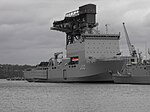
| |
| Hsu Hai (LSD-193) | 1 | 2000 | 169 m (554 ft) | 26.0 m (85.3 ft) | 6.1 m (20 ft) | 14,225 | Ex-USS Pensacola (LSD-38) sold to Republic of China (Taiwan) Navy in 2000. | 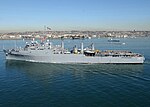
| |
| Ivan Gren | 2 | 2016 | 120 m (390 ft) | 16.0 m (52.5 ft) | 6,600 | Two more building to an improved design | 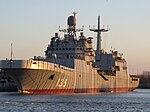
| ||
| Bay | 3 | 2007 | 176.6 m (579 ft) | 26.4 m (87 ft) | 5.8 m (19 ft) | 17,810 | 
| ||
| Whidbey Island | 6 | 1985 | 186 m (610 ft) | 26.0 m (85.3 ft) | 5.94 m (19.5 ft) | 16,100 | 
| ||
| Harpers Ferry | 4 | 1995 | 185.80 m (609.6 ft) | 26.0 m (85.3 ft) | 5.94 m (19.5 ft) | 19,600 | 
|
Decommissioned
[edit]| Land | Class | Out of service | Commissioned | Length | Beam | Draft | Displacement (mt) | Note | |
|---|---|---|---|---|---|---|---|---|---|
| Cándido de Lasala (Q-43) | 1 | 1970–1981 | 139.5 m (458 ft) | 22.0 m (72.2 ft) | 4.83 m (15.8 ft) | 7,930 | Ex-USS Gunston Hall (LSD-5) sold to Argentina in 1970, scrapped after 1981. | 
| |
| Ceará (G-30), Rio de Janeiro (G-31) | 2 | 1990–2012 | 160 m (520 ft) | 26.0 m (85.3 ft) | 5.94 m (19.5 ft) | 11,989 | Ex-USS Hermitage (LSD-34) loaned in 1989 and later sold to Brazilian Navy, sunk as target 2021; ex-USS Alamo (LSD-33) loaned to Brazilian Navy in 1990, scrapped 2015 Turkey. | 
| |
| Chung Cheng (LSD-191) | 1 | 1977–1985 | 139.5 m (458 ft) | 22.0 m (72.2 ft) | 4.83 m (15.8 ft) | 7,930 | Ex-USS White Marsh (LSD-8) loaned to the ROC Navy in 1960, scrapped 1985. | ||
| Chung Cheng (LSD-191) | 1 | 1984–2012 | 139.5 m (458 ft) | 22.0 m (72.2 ft) | 4.83 m (15.8 ft) | 7,930 | Ex-USS Comstock (LSD-19) sold for scrapping 1984, salvaged by ROC Navy, sunk as artificial reef June 2015. | 
| |
| Ivan Rogov | 3 | 1978–2002 | 157 m (515 ft) | 23.8 m (78 ft) | 6.7 m (22 ft) | 14,060 | Ivan Rogov and Aleksandr Nikolayev are now being preserved; Mitrofan Moskalenko auctioned off for scrapping in 2012.[5] | 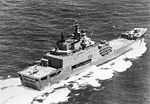
| |
| Ashland | 8 | 1943–1969 | 139.5 m (458 ft) | 22.0 m (72.2 ft) | 4.83 m (15.8 ft) | 7,930 | Ex-USS Gunston Hall (LSD-5) sold to Argentina; Ex-USS White Marsh (LSD-8) sold to Taiwan; rest scrapped from 1968 to 1970. | 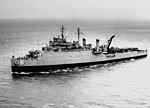
| |
| Casa Grande | 13 | 1944–1970 | 139.5 m (458 ft) | 22.0 m (72.2 ft) | 4.83 m (15.8 ft) | 7,930 | Last ship ex-USS Shadwell (LSD-15) scrapped in 2017. | 
| |
| Thomaston | 8 | 1954–1990 | 160 m (520 ft) | 26.0 m (85.3 ft) | 5.94 m (19.5 ft) | 11,989 | Ex-USS Alamo (LSD-33) loaned to Brazilian Navy; ex-USS Hermitage (LSD-34) loaned and later sold to Brazilian Navy; all other scrapped or sunk as target | 
| |
| Anchorage | 5 | 1969–2003 | 169 m (554 ft) | 26.0 m (85.3 ft) | 6.1 m (20 ft) | 14,225 | Ex-USS Pensacola (LSD-38) sold to Republic of China (Taiwan) Navy and only active ship with all others scrapped or sunk as target. | 
| |
| Whidbey Island | 2 | 1985–present | 186 m (610 ft) | 26.0 m (85.3 ft) | 6.1 m (20 ft) | 16,100 | Whidbey Island and Fort McHenry in inactive reserve |
See also
[edit]- List of amphibious warfare ships
- List of United States Navy amphibious warfare ships § Landing Ship Dock (LSD)
- Roll-on/roll-off
- USNS Point Barrow (T-AKD-1), a cargo ship of similar design
References
[edit]- ^ "Mother of Minesweepers". Popular Mechanics: 97–104, see drawings pp. 98–99. February 1952.
- ^ a b "World Wide Landing Ship Dock/Landing Platform Dock". Retrieved 2012-05-17.
- ^ Brown 2006, p. 145
- ^ Petty, Dan. "The US Navy -- Fact File: Dock Landing Ship - LSD". Navy.mil. Retrieved 27 October 2018.
- ^ "Barentsobserver". Barentsobserver.com. Retrieved 27 October 2018.
Bibliography
[edit]- Brown, D. K. (November 2006). Nelson to Vanguard. Annapolis, Maryland: US Naval Institute Press. ISBN 1-59114-602-X.
External links
[edit]- US Navy Office of Information Fact File – LSD Archived 2011-03-11 at the Wayback Machine
